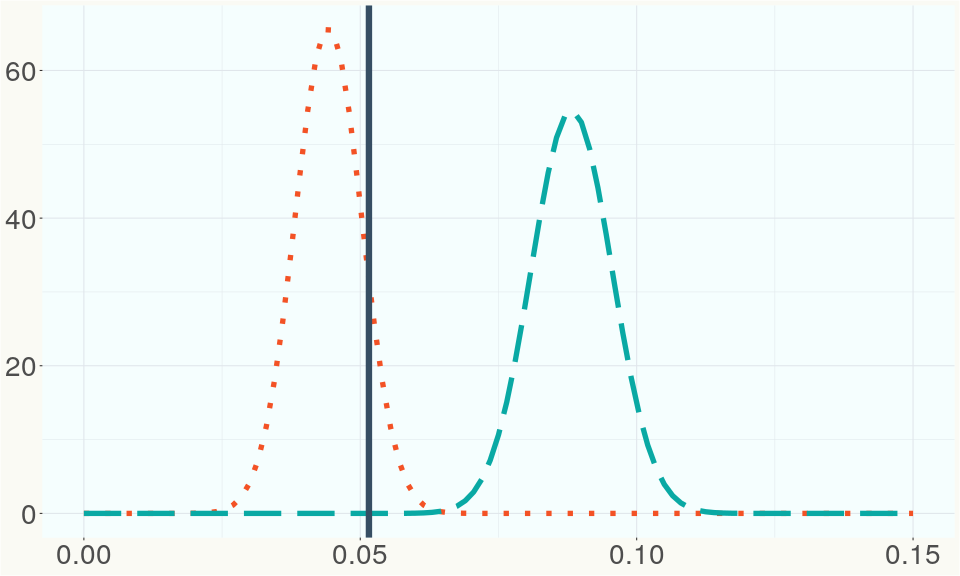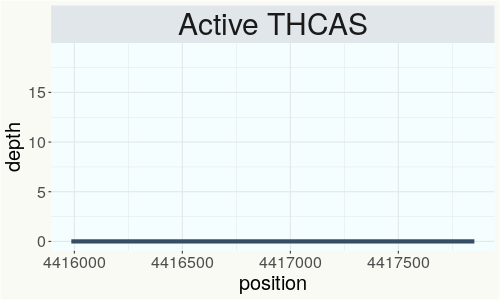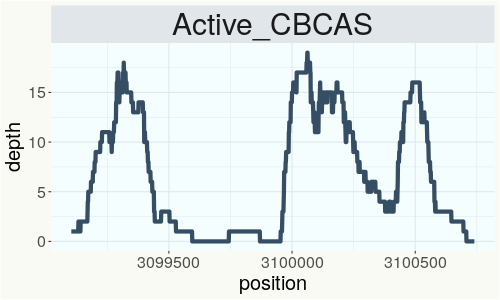USO 31
RSP 10981
General Information
- Sample Name
- USO31_1_2_CSU
- Accession Date
- July 16, 2017
- Reported Plant Sex
- Hermaphrodite
- Report Type
- StrainSEEK v2 3.2Mb
- DNA Extracted From
- Unknown
The strain rarity visualization shows how distant the strain is from the other cultivars in the Kannapedia database. The y-axis represents genetic distance, getting farther as you go up. The width of the visualization at any position along the y-axis shows how many strains there are in the database at that genetic distance. So, a common strain will have a more bottom-heavy shape, while uncommon and rare cultivars will have a visualization that is generally shifted towards the top.
Chemical Information
Cannabinoid and terpenoid information provided by the grower.
Cannabinoids
No information provided.
Terpenoids
No information provided.
Genetic Information
- Plant Type
- Type III
File Downloads
The bell curve in the heterozygosity visualization shows the distribution of heterozygosity levels for cannabis cultivars in the Kannapedia database. The green line shows where this particular strain fits within the distribution. Heterozygosity is associated with heterosis (aka hybrid vigor) but also leads to the production of more variable offspring. When plants have two genetically different parents, heterozygosity levels will be higher than if it has been inbred or backcrossed repeatedly.
The ratio of reads mapped to Y-contigs to reads mapped to the whole Cannabis genome (Y-ratios) has been demonstrated to be strongly correlated with plant sex typing. This plot shows the distribution of Y-ratios for all samples in our database which were sequenced with the same method (panel or WGS) as this sample and where this sample falls in the distribution.

This chart represents the Illumina sequence coverage over the Bt/Bd allele. These are the three regions in the cannabis genome that impact THCA, CBDA, CBGA production. Coverage over the Active CBDAS gene is highly correlated with Type II and Type III plants as described by Etienne de Meijer. Coverage over the THCA gene is highly correlated with Type I and Type II plants but is anti-correlated with Type III plants. Type I plants require coverage over the inactive CBDA loci and no coverage over the Active CBDA gene. Lack of coverage over the Active CBDA and Active THCA allele are presumed to be Type IV plants (CBGA dominant). While deletions of entire THCAS and CBDAS genes are the most common Bt:Bd alleles observed, it is possible to have plants with these genes where functional expression of the enzyme is disrupted by deactivating point mutations (Kojoma et al. 2006).



This chart represents the Illumina sequence coverage over the CBCA synthase gene.

Variants (THCAS, CBDAS, and CBCAS)
No variants to report
Variants (Select Genes of Interest)
Nearest genetic relatives (All Samples)
- 0.006 USO 31 (RSP10983)
- 0.144 Lovrin (RSP10658)
- 0.153 Carmagnola USO 31 (RSP11204)
- 0.172 USO31 (RSP10233)
- 0.173 Santhica27 (RSP10056)
- 0.177 R1in136 (SRR14708226)
- 0.180 Tygra (RSP10667)
- 0.184 Santhica27 (RSP11047)
- 0.190 Santhica27 (RSP11046)
- 0.194 Fedora 17 (RSP11203)
- 0.194 Diana (RSP10235)
- 0.199 Ivory (RSP10668)
- 0.200 Juso14 (SRR14708259)
- 0.200 R1in136 (SRR14708227)
- 0.201 Beniko (SRR14708275)
- 0.203 Futura 75 (RSP10664)
- 0.203 R1in136 (SRR14708225)
- 0.203 Fedora 17 (RSP10661)
- 0.204 Santhica 27 (RSP10665)
- 0.204 Santhica 27 (SRR14708211)
Most genetically distant strains (All Samples)
- 0.444 Cherry Blossom (RSP11323)
- 0.430 Cherry Blossom (RSP11312)
- 0.426 Cherry Blossom (RSP11298)
- 0.419 Chematonic -Cannatonic x Chemdawg- (RSP11394)
- 0.416 Chem 91 (RSP11185)
- 0.415 Cherry Blossom (RSP11318)
- 0.411 Cherry Blossom (RSP11328)
- 0.410 JL Cross 11 (RSP11512)
- 0.404 GG4 (RSP11978)
- 0.402 RKM-2018-002 (RSP11093)
- 0.402 Cherry Blossom (RSP11331)
- 0.402 Cherry Blossom (RSP11329)
- 0.401 Cherry Blossom (RSP11310)
- 0.401 Cherry Blossom (RSP11322)
- 0.401 Cherry Blossom (RSP11301)
- 0.399 New York City Deisel (RSP11225)
- 0.399 CHEM4 (RSP12090)
- 0.399 BagSeed (RSP12627)
- 0.399 YMCM (RSP11416)
- 0.398 Cherry Blossom (RSP11300)
Nearest genetic relative in Phylos dataset
- Overlapping SNPs:
- 103
- Concordance:
- 73
Nearest genetic relative in Lynch dataset
- Overlapping SNPs:
- 6
- Concordance:
- 5
Blockchain Registration Information
- Transaction ID
-
8c433e8bb7b460d8
bad3da4f99bad228 6d42e78126e61427 fe54f0297f41c762 - Stamping Certificate
- Download PDF (854.5 KB)
- SHASUM Hash
-
f86d8dc9eee5529a3890295ad0ee64c8 651af9f2d1c01624 8e7cba7d70a2c6ac